FAQ
FAQ
Frequently Asked Questions
Tyre Problems
Are punctures/cuts covered under the warranty?
Our warranty covers defects in workmanship and material for the life of the tread or 3 years from date of purchase (if tyre is purchased within 3 years from date of manufacture) or 6 years from date of manufacture (if tyre purchased is more than 3 years from date of manufacture), whichever occurs first. We do not cover tyres that are damaged as a result of road hazards, cuts, punctures, impact, Tread Aggression, uneven wear or quick wear, vehicle irregularity, etc. For complete details, take a look at The Michelin Warranty.
Can I replace a Run-Flat tyre with a standard one?
No. Michelin does not recommend changing run flat tyres with standard tyres. The Michelin Run Flat tyres have reinforced sidewalls designed to support the load of the vehicle in case of a pressure drop and allow continued driving for up to 80 kilometers (depending on road and driving conditions) at a maximum speed of 80 kilometers. Standard tyres do not have this technology.
Is a Bubble/ 'Bulge on the sidewall of my tyre covered by your warranty?
A bulge or bubble in the sidewall is sometimes the result of damage from coming in contact with a curb, pothole or other object. Evidence of this damage can be:
- a scuff mark on the sidewall near the bubble
- a dent or damage on the wheel above the bulge
- a cut or bruise on the inner liner of the tyre in the vicinity of the bulge (the tyre must be demounted in order to inspect the inner liner).
A tyre that sustains any of the above injuries is damaged and is not covered under warranty.
What are road hazard injuries?
Road hazard damage is damage that occurs when a tyre fails as a result of a puncture, bruise or break incurred during the course of normal driving on a maintained road. Nails, glass and potholes are the most common examples of road hazards.
Avoid running over objects (e.g.potholes, rocks, curbs, metal, glass, etc.) which may cause internal tyre damage. Internal damage, which is not visible without demounting the tyre, may be caused when a tyre runs over an object. Continued use of a tyre that has suffered internal damage (which may not be externally visible) can lead to dangerous tyre failure. Determination of suspected internal damage requires demounting the tyre from its rim and examination by trained tyre personnel.
What are the causes of center tread wear?
When the center tread wears faster than the adjacent tread surfaces, possible causes include over inflation for the load carried, rim width too narrow, misapplication, smooth wear after spin-out, improper tyre rotation practices, aggressive acceleration or under inflation for certain tyre types, such as performance tyres.
If the tread depth is at or below 1.6mm in any groove or if cord material or under tread is exposed, the tyre must be replaced. If sufficient tread remains, verify proper rim width and vehicle fitment as well as verify/adjust inflation pressures, then rotate the tyres for maximum wear.
What can cause my tyre to show One-Sided Shoulder Wear?
When the shoulder of the tread on one side of a tyre wears faster than the adjacent tread surface, this can result from a variety of conditions, such as front and/or rear misalignment (example, toe or camber), loose or worn suspension components, hard cornering, improper tyre rotation practices, misapplication, high crown roads or non-uniform mounting. If the tread depth is at or below 1.6mm any groove or if either cord or under tread is exposed, the tyre must be replaced. If sufficient tread remains, verify that the tyre has been properly mounted, then rotate the tyres for maximum wear.
What can cause my tyre to wear in more than one spot around the circumference?
When tread is worn in one or more spots around the tyre circumference, this can indicate brake lock/skid, improper balance, localized underlying separation, loose/worn suspension components, improper bead seating/mounting, progression from initial tread cut/chip/road hazard injury or chemical contamination. Surface texture may have initially shown abrasion marks from the tyre sliding on the road, but the surface may have since worn smooth.
When tyres with a flat spot are used in a dual application. you may consider rotating one tyre 180 degrees in relation to the flat spot on the other tyre.
If the tread depth is at or below 1.6mm in any groove or if either cord or under tread is exposed, the tyre must be replaced.
What can cause my tyre tread face to show one rib higher than the other?
Feathering is a condition when the edge of each tread rib develops a slightly rounded edge on one side and a sharp edge on the other. The most common causes of feathering are incorrect toe-in setting or deteriorated bushings in the front suspension. The toe setting should be based on the vehicle manufacturer’s recommendation.
The tyres should be inflated to the pressure as indicated on the sticker on the inside of the driver’s door or on the inside of fuel lid. The vehicle manufacturer has determined this pressure is optimal for load, ride, handling, rolling resistance and tread wear performance.
What can cause the sidewall of my tyres to start turning a brownish color?
The brownish color on the sidewall of your tyres is not a defect. The source of this discoloration can be varied. One possibility is that the tyres contain an anti-ozone agent in their rubber compounds to slow down the ill effects of exposure to ozone in the air. This anti-ozone ingredient will migrate to the surface of the rubber and leave the appearance of a brownish dust. This is completely normal and technically is no cause for concern. In time, depending on usage, it will disappear.
Other possibilities for discoloration can be simply dust that is picked up from normal driving or brake dust which is generated by the abrasion of the brake pads against the brake rotor. This latter condition is more prevalent when the brakes are new or have recently been relined. In all cases, we recommend that you continue to clean your tyres with a mild soap and water occasionally. It is recommended to not use pressure jets or strong soap solutions to clean the tyre.
What causes a tyre to wear out?
Treadwear or life expectancy is determined by many factors:
- Driving habits and style of driving, geographical location, type of vehicle, type of tyre, how vehicle is maintained, how tyres are maintained, etc.
- As a result, mileage expectancy is impossible to determine.
- Our Warranty covers defects in workmanship and material for the life of the tread or 3 years from date of purchase (if tyre is purchased within 3 years from date of manufacture) or 6 years from date of manufacture (if tyre purchased is >3 years from date of manufacture), whichever occurs first.
- We suggest that you have the tyres/vehicle inspected by a participating tyre retailer in your area to determine if there is perhaps a mechanical or maintenance issue that could be contributing to a rapid or irregular wear pattern.
Your satisfaction is important to us. If you need assistance in locating a participating tyre retailer, please visit our Website or call us at 0860 100 480.
Contact Us & Dealer Locator
What causes sidewall Indentations on my tyre?
The condition, sometimes referred to as sidewall undulations, is a common characteristic of radial tyre construction and is purely a visual characteristic and will not affect the performance of the tyre. These indentations are more noticeable in larger/wider radial-ply tyre sizes and become more visible with higher inflation pressures. The joining of the ply material in the sidewall area may cause a slight indentation or wavy appearance on the sidewall surface of the tyre when it is inflated. However, if bulges, rather than indentations appear on the sidewall of the tyre, or if there is any question concerning any sidewall indentations, please visit your nearest participating tyre retailer. If you need assistance locating a participating tyre retailer, please visit our website or call us at 0860 100 480.
What could be the cause of my tyres making a loud noise?
Noise is most commonly due to an uneven or irregular wear pattern that has developed on the tyres. Sometimes noise could be a perception or feeling one may perceive especially after changing to a new set of tyres. We suggest that you have the tyres inspected by an participating tyre retailer in your area.
What could cause my tyre to wear on the Inside and outside shoulders?
The cause of inside and outside shoulder wear is normally due to improper inflation pressure, hard cornering, driving on crowned roads, improper tyre rotation practices or a rim width too wide for the tyre.
If the tyre's tread depth is at or below 1.6mm in any groove or if cord material or under tread is exposed, the tyre must be replaced. If sufficient tread remains, verify proper rim width and vehicle fitment as well as verify/adjust inflation pressures, then rotate the tyres for maximum wear.
What could cause my tyre tread to come off?
A separation between the tread rubber and the underlying belt may be the result of cumulative poor inflation maintenance, improper inflation pressure, repair or storage, excessive load, speed or heat, prior impact damage, tread cut or puncture or run flat.
A tyre exhibiting this condition should be permanently removed from service.
What does it mean if my tyre has shredded into pieces?
The tyre industry refers to tyres in this condition as ""run flat"" which refers to a tyre that has lost air, whether it is from a slow loss or an immediate loss, and then subsequently run on. As the tyre continues to operate or ""run"" with significant amount of air loss, it reaches the ""runflat"" stage, where serious internal damage is caused by the excessive deflection of the casing. If the air loss continues, the inside of the deflected sidewall can actually rub against itself. When the internal abrasion weakens the casing sufficiently a blowout can occur. Additional damage is often done by the relatively sharp rim flange cutting into the fully deflated casing as it is driven after the blowout, even in the short distance it takes to drive the vehicle to the side of the road.
We are not indicating that the tyre was not maintained, but simply that it lost air. Some of the many factors which can cause a tyre to lose its inflated air pressure are penetrations, cuts, snags, impact breaks, valve stem leaks, incorrect mounting, just to name a few. While it may not be possible to pinpoint the cause of initial air loss, we know the outcome is underinflation damage.
A tyre exhibiting this condition should be permanently removed from service.
What does it mean when my tyres start to show signs of aging, ozone cracking or weather cracking?
The life of a tyre cannot be measured by kilometres alone. Tyres are composed of various types of material and rubber compounds, having performance properties essential to the proper functioning of the tyre itself. These component properties evolve over time. For each tyre, this evolution depends upon many factors such as weather, storage many factors such as weather, storage conditions, and conditions of use (load, speed, inflation pressure, maintenance etc.) to which the tyre is subjected throughout its life. This service-related evolution varies widely so that accurately predicting the serviceable life of any specific tyre in advance is not possible.
It is impossible to predict when tyres should be replaced based on their calendar age alone. However the older a tyre the greater the chance that it will need to be replaced due to the service-related evolution or other conditions found upon inspection or detected during use.
While most tyres will need replacement before they achieve 10 years, it is recommended that any tyres in service 10 years or more from the date of manufacture, including spare tyres, be replaced with new tyres as a simple precaution even if such tyres appear serviceable and even if they have not reached the legal wear limit.
What is Cupping?
Cupping can be attributed to bent or worn suspension parts, wheel misalignment, an imbalance of the tyre/wheel assembly, etc. Once this type of wear pattern has occurred, it is irreversible and the tyres will continue to wear unevenly.
What should I do if I notice a vibration?
Vibration is an indication that your car has a problem that needs attention. The Tyre-Wheel assembly, steering system and suspension system should be checked to help determine the possible cause and correction of the vibration. If left unattended, the vibration could cause excessive tyre and suspension wear. It could even be dangerous. Authorized Dealers offer expert diagnosis and repair. If you need assistance locating a participating tyre retailer, please visit our website or call us at 0860 100 480.
What should I do if my tyres wore too fast?
An inspection of your tyres must be performed by a participating tyre retailer to ascertain the cause for low tyre mileage. You may also need to get the vehicle inspected by an OEM authorised or Michelin Authorised Tyre Dealer service workshop to rule out any vehicle irregularity.
Factors that can affect rapid tyre life are:
- tyre maintenance (inflation and rotation)
- vehicle maintenance (alignment and suspension)
- driving styles and habits
- materials used in road surfaces
- topography of the area the vehicle is driven in.
What should I do if my vehicle is pulling to one side?
Incorrect alignment settings can adversely affect handling. Tolerable camber, caster and toe settings can be verified by a print-out from your alignment/tyre shop or vehicle dealer.
If the tyres are evenly worn, the alignment is in order and there is still a pull, the front tyres should be criss-crossed (as long as they are not a directional tread design) to see if the pull changes directions.
This should be performed by a participating dealer.
What should I do if the cords on my tyres are visible?
What should I do if the cords on my tyres are visible?
Cord material may become visible at the base of tread grooves or slots due to under inflation, misalignment, loose/worn suspension components, hard cornering, improper tyre rotation practices, misapplication, high crown road or non-uniform mounting.
A tyre exhibiting this condition should be permanently removed from service.
Tyre Replacement and Care
Can I mix different speed-rated tyres on my car?
If tyres of different speed ratings are mounted on a vehicle, the lower speed-rated tyres should be placed on the front axle. This is to prevent a potential oversteering or understeering condition in both wet and dry roads. Vehicle handling may be affected, and the vehicle’s speed capacity is now limited to the lowest speed-rated tyre. Ensure that the speed index of the tyre is at par or more than the vehicle maker recommendation. Also ensure to never mix tyres of different speed index on the same axle.
Can I mix tyre types on my car?
For best all-around performance, the same type tyre should be used on all four-wheel positions. Tyres of different size designations, constructions, and stages of wear may affect vehicle handling and stability. NOTE: Some vehicles are intentionally fitted with different size tyres on front and rear.
For four-wheel drive vehicles, if no instructions for tyre mixing appear in the vehicle owner’s manual, adhere to the following guidelines:
- Do not mix sizes. All four tyres must be branded with the same tyre size.
- Do not mix radial and bias-ply tyres. All four must be either radial or bias-ply.
- Be sure that the outside circumference of all four tyres is within 1” of each other.
- Do not mix different tread patterns on the same axle.
Can I replace the tyres on my car with a lower speed-rated tyre
When replacing speed-rated tyres, you must use replacement tyres with ratings equal to or greater than those of the original equipment tyres, if the speed capability of the vehicle is to be maintained. The handling of a performance vehicle may be different when the replacement tyres are not the same speed rating. Refer to the vehicle owner’s manual to identify any tyre speed rating restriction that could affect operation of the vehicle.
Do I have to replace my present tyres with the same size tyres?
Never choose a tyre that is smaller in size or has less load-carrying capacity than the tyre that came with the vehicle. Tyres should always be replaced with the same size designation — or approved options — as recommended by the vehicle or tyre manufacturer. The correct tyre size can be found on the door placard of the vehicle or by consulting your local authorised Michelin retailer. Your current tyres’ size can be found by reading the markings on the sidewall.
For upsizing, one needs to keep in mind the below conditions:
- The Load & speed indexes should be equal or greater than the OE fitment
- The overall diameter of tyre replacement should be within the range of -2 to +1.5% overall diamter of the OE fitment size
- Replacement tyre should not touch any vehicle parts stationarily or during use (to be confirmed upon fitment)
In case of changing wheel size, always prefer to stick to OE fitment or maximum of 1 inch in diameter.
The above recommendation is Michelin recommendation only, contact your vehicle maker for their recommendation.
Where do I install new tyres if I only buy two
Michelin recommends replacing all four tyres at the same time, however if replacing only two new tyres, be sure that the new tyres are the same size & tyre type as the current tyres and that the dealer always installs the new tyres on the front axle of the vehicle.
Why Put the 2 New Tyres on the Front Axle?
- The New tyres will provide better wet grip than your half-worn tyres. Fitting new tyres on front axle helps in avoiding oversteering condition during cornering.
- It will help reduce the potential for the vehicle to fishtail and lose stability in wet conditions.
Can I use tyre dressings
We recommend using a soft brush and mild soap to clean tyres. Tyre dressings that contain petroleum products or alcohol can accelerate the aging process and contribute to cracking.
Michelin does not endorse the use of after-market conditioners. The effects of such products are unknown as it would be impossible to test all of the products on the market today.
Do my driving habits affect the life of my tyres
Yes. Here are several tips to help increase the life of your tyres:
- Don’t speed. High speeds can generate excessive heat, which can increase the rate of tyre wear. Drive the safe, legal speed limit.
- Avoid fast turns on curves and around corners.
- Avoid fast starts and panic stops.
- Don’t ride on the edge of the pavement or drive over curbs, potholes, or other obstructions.
Do my new tyres require special treatment?
Special treatment is not required for your new tyres. However, drive carefully while you get accustomed to them. You may feel a difference when accelerating, braking, and cornering or possibly driving in wet conditions.
Do you recommend the use of after-market balancing/sealant products
We cannot test all products being marketed today, and do not certify or endorse any of these after-market products for efficiency or compatibility.
Because some of these products may degrade the inner liner of tyres, caution should be taken. The long term effect of these products is unknown (chemical reaction when exposed to pressure, temperature and time).
Because some of these products may be flammable, we strongly urge you to be cautious while dealing with such products. Failure to do so could lead to serious injury or death.
Please refer to the warnings and instructions provided by the manufacturers of these products regarding their use.
We neither approve nor disapprove the use of these products.
How and when should I rotate my tyres

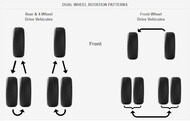
How do I know how old my tyres are?
Each tyre on one of the sidewall has the required manufacturing details. The alphanumeric can be upto 12 characters. The first and last digits are the most important:
- The first two letters or numbers identify the tyre’s manufacturer and plant code.
- Prior to the year 2000, the last 3 digits of a DOT number represented the week (2 digits) and the year (1 digit) of production. So if the last three digits are 439, the tyre was produced in the 43rd week of 1999.
- Tyres produced after January 1, 2000, have a 4-digit date code at the end of the DOT number. The first 2 digits represent the week of production and the last 2 digits represent the last 2 digits of the year of production. So, 3500 indicates the tyre was produced in the 35th week of the year 2000.
How do I take care of my new tyres?
Properly maintained tyres can help give you a more comfortable ride and a longer tread life.
- Check your tyre pressure periodically with a tyre pressure gauge (and make sure the tyres are cold—at least 3 hours after driving or within 2 km of initial use.
- Check your tyres frequently for any cuts, snags, punctures, any other injury, or irregular tyre wear.
- At the first sign of irregular tread wear, have your alignment checked.
- Make sure that the tyres are balanced when they are mounted on the wheels.
- Rotate your tyres following the schedule in your vehicle owners manual or as required by the tyre manufacturer’s warranty.
How long should my original equipment tyres last?
We do not offer a written mileage warranty on any tyres supplied as original equipment. Due to the variety of styles, construction features, tread compounds, vehicle applications, geographical conditions and driving habits, it is difficult to provide a specific mileage expectancy.
However, any tyre wear concern should always be presented to your participating tyre retailer for further evaluation.
What will be my tyre mileage in Kilometers?
Many factors can affect the tread life of your tyres, such as:
- Tread compounds
- Construction features
- Vehicle application
- Tyre maintenance
- Geographic conditions
- Atmospheric conditions
- Driving habits
- And more
That’s why exact mileage is impossible to predict. Take special care when braking, accelerating, cornering, etc., to help increase the life of the tyre. (Owning tyres with Michelin’s technology doesn’t hurt either.) If you have concerns about the rate of wear on your tyres, consult your participating tyre retailer.
How should I care for tyres I have in storage?
Tyres should be stored in a cool place away from direct sunlight, sources of heat and ozone such as hot pipes and electric generators. Exposure to these elements during prolonged periods of time will exhaust the tyre's oxidation and weathering agents within the rubber compounds and result in cracking. Be sure that surfaces on which tyres are stored are clean and free from grease, gasoline or other substances that could deteriorate the rubber.
For mounted tyres inflate at, but no higher than, the recommended air pressure. Store vehicle on blocks to remove load from the tyres, especially in case of long term storage of tyres. Also ensure that tyres are not exposed to excessive heat, ozone or come in close contact with electrical equipment like transformers.
Is it safe to repair a flat tyre?
If a tyre loses all or most of its air pressure, it must be removed from the wheel for a complete internal inspection to be sure it's not damaged. Tyres that are run even short distances while flat are often damaged beyond repair. Most punctures, nail holes, or cuts up to 6 mm and angle of injury < 15 degrees confined to the tread -- may be satisfactorily repaired by trained personnel using industry-approved methods, such as mushroom repairs. Don't repair tyres with tread punctures larger than 6mm or angle of injury <15 degrees (if repair is within repairable limits on tread area)or any sidewall puncture. Also, never repair tyres which are worn below 1.6 mm tread depth. Your best bet is to make sure your spare tyre is always ready to do the job. Check it regularly for proper air pressure and be sure that it is in good shape. If your car is equipped with one of the several types of temporary spares, be sure to check the spare tyre's sidewall for the correct inflation pressure, speed, and mileage limitations. Always get the tyre repaired only by a tyre expert.
Certain type of tyres like run-flat tyres are not recommended to be repaired more than once. Customers should be cautious about the same.
Is there a time period on breaking in my new tyres?
New tyres have to be driven a few hundred kilometres on dry roads to rid the tread of parting agents and antioxidants applied during production. Not until the tread has been slightly roughened will the tyre be able to make its true gripping power felt.
Is there a way to tell when I need new tyres?
Tread wear indicators ("wear bars") are located at the base of the main grooves and are equally spaced around the tyre. The tread wear indicators, which look like narrow strips of smooth rubber across the tread, will appear on the tyre when that point of wear is reached. When you see these wear bars, the tyre is worn out and it's time to replace the tyre. Always remove tyres from service when they reach a remaining tread depth of 1.6mm tread depth.
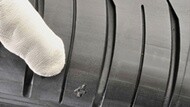
Must I replace my present tyres with the same size tyres?
Never choose a smaller size than those that came with the car. tyres should always be replaced with the same size designation -- or approved options — as recommended by the vehicle manufacturer or authorized dealer.
For best all-around performance, the same type tyre should be used on all four-wheel positions. tyres of different size designations, constructions, and stages of wear may affect vehicle handling and stability.
NOTE: Some vehicles are intentionally fitted with different size tyres on front and rear.
For four-wheel drive vehicles, if no instructions for tyre mixing appear in the vehicle owner’s manual, adhere to the following guidelines:
- Do not mix sizes. All four tyres must be branded with the same tyre size.
- Do not mix radial and bias-ply tyres. All four must be either radial or bias-ply.
- Be sure that the outside circumference of all four tyres is within 1” of each other.
- Do not mix different tread patterns on the same axle.
Should my tyres be balanced?
Proper balancing is critical for optimal vehicle performance, especially at today's higher highway speeds. When tyre and wheel assemblies are unbalanced, a vibration can result from wheel and assembly shimmy (shaking from side to side) or wheel assembly tramp (tyre and wheel hopping up and down). Therefore, it is important that these assemblies are in both static and dynamic balance.
What air pressure do you recommend when using an Optional tyre size?
When installing a different size than the original equipment tyre, all vehicle manufacturer specifications must be maintained. The replacement tyre should be inflated to provide the same load capability of the original tyre size at the manufacturer’s recommended pressure.
What is proper alignment?
A vehicle is said to be properly aligned when all suspension and steering components are sound and when the tyre and wheel assemblies are running straight and true. Proper alignment is necessary for even tread wear and precise steering. Uneven front or rear tyre wear, or changes in your vehicle's handling or steering response (i.e. pulling to one side) can indicate misalignment. Some vehicles today are equipped with rear suspensions that can be adjusted for alignment. Irrespective of the symptoms you are experiencing, a four wheel alignment check is suggested.
The moderate cost of having your vehicle aligned can more than pay for itself in tyre mileage, performance and comfort.
What is the correct air pressure for my tyres?
The vehicle manufacturer selects the size and type of tyres for their vehicles. They perform the necessary testing to establish the vehicles’ optimized operating tyre inflation pressures which can be found on the vehicle placard (located on the inside of the driver's door) and in the vehicle owners’ manual.
If the tyres on your vehicle are the same size as the original equipment tyre, inflate them to the pressures indicated on the placard.
If the size of the tyres is different than the size indicated on the placard, please contact us via phone or email for a pressure recommendation. We will need the following information from the tyre and wheel placard:
- the original equipment tyre size
- the vehicle manufacturer's inflation pressure.
What is the expected service life of tyres?
While most tyres will need replacement before they achieve 10 years, it is recommended that any tyres in service 10 years or more from the date of manufacture, including spare tyres, be replaced with new tyres as a simple precaution even if such tyres appear serviceable and even if they have not reached the legal wear limit.
What is your opinion on the use of nitrogen in tyres?
Nitrogen is an inert gas. It is simply dry air with the oxygen removed (air contains nearly 79% Nitrogen). The physical properties of nitrogen reduce the pressure loss due to the natural permeability of the materials of the tyre. Unfortunately, there are other possible sources of leaks (tyre/rim interface, valve, valve/rim interface and the wheel) which prevent the guarantee of pressure maintenance for individuals using air or nitrogen inflation. tyres manufactured by Michelin are designed to deliver their expected performance when inflated with air or nitrogen, as long as, the user respects the pressures recommended by the vehicle manufacturer on the vehicle's placard or by the tyre manufacturer. Whether they are inflated with air or nitrogen, regular pressure maintenance remains critical because under-inflated tyres lead to:
- a reduction in road holding
- a reduction in wet traction capability
- an increased sensitivity to road hazards
- a reduction in treadlife
- an increase in fuel consumption
- a reduction in tyre life due to excessive heat from over deflection
What should I look for when inspecting my tyres?
In addition to performing regular maintenance, you must also keep an eye out for potential problems that might affect your tyres. Regular inspections can help you prevent tyre trouble, and keep you rolling safely down the road.
When inspecting your tyres, look for:
Uneven tread wear. This can include more wear on one tread edge than the other, a rippled pattern of high and low wear, or exposed steel wire. Uneven wear can be caused by problems such as under inflation, misalignment and improper balancing.
Shallow tread. Bald tyres tend to skid and slide on the pavement, and are more likely to be damaged by potholes and other road hazards. The tread on your tyre should be at least 1.6mm deep. If it isn’t, the tyre must be replaced. To help you see tread problems, tyres have built-in “tread wear indicators.” These are narrow bars of smooth rubber that run across the tread: When the tread is even with the bars, it is worn down to the minimum level and must be replaced immediately.

Troublemakers. Check for small stones, pieces of glass, bits of metal and other foreign objects that might be wedged into the tread, and carefully pick them out. They can cause serious problems if they are pushed further into your tyre as you drive.
Damaged areas. Cracks, cuts, splits, punctures, holes and bulges in the tread or on the sides of the tyre can indicate serious problems, and the tyre may need to be replaced.
Slow leaks. Tyres lose some air pressure (about 0.14 bar ) over the course of a month or so, but if you find that you have to add air every few days, have the tyre, wheel and valve checked—and if necessary, repair or replace the tyre.
Valve caps. Those little caps on your tyre’s valve stem keep moisture and dirt out, so make sure they are on all your tyres. Also, when you have a tyre replaced, have a new valve stem/valve nozzle assembly installed at the same time.
Driving on a damaged tyre can be dangerous. If you see something you’re not sure about during your inspection, have it examined by your tyre dealer. Any time you see damage to a tyre, don’t drive on it—use a spare if you need to go somewhere. And finally, pay attention to the “feel” of your tyres as you drive. A rough ride may indicate tyre damage or excessive wear. If you notice vibrations or other disturbances while driving, and/or you suspect possible damage to your tyre or vehicle, immediately reduce speed, drive with caution until you can safely pull off the road and stop, and inspect your tyres. If a tyre is damaged, deflate it and replace it with your spare. If you do not see any tyre damage and cannot identify the source of the vibration, take the vehicle to a tyre dealer for a thorough inspection.
When should I check my air pressure?
Air pressure in tyres, including the spare, should be checked once fortnightly/once in two weeks and always before extended driving. Tyres should be checked when they are cold (at least three hours after the vehicle has been stopped and before it is driven more than one or two kilometers). Do not reduce pressure when tyres are hot; use an accurate air pressure gauge to check pressure and maintain it at the level recommended on the vehicle tyre vehicle placard or in the vehicle owner’s manual. Under-inflation produces extreme flexing of the tyre and builds up heat to the point that tyre failure may occur. Over- or under-inflation may adversely affect vehicle handling. Cold tyre pressures should never be higher than the limit molded on the sidewall. Be cautious to never bleed the tyres when hot.
When should I replace my spare tyre?
While most tyres will need replacement before they achieve 10 years, it is recommended that any tyres in service 10 years or more from the date of manufacture, including spare tyres, be replaced with new tyres as a simple precaution even if such tyres appear serviceable and even if they have not reached the legal wear limit.
For tyres that were on an original equipment vehicle (i.e., acquired by the consumer on a new vehicle), follow the vehicle manufacturer’s tyre replacement recommendations, when specified (but not to exceed 10 years).
The date when a tyre was manufactured is located on the sidewall of each tyre. Consumers can locate the code where the last four digits of the code provide week and year of manufacture. For example, a DOT code ending with “2204” indicates a tyre made in the 22nd week (May) of 2004.
When should worn tyres be replaced?
Worn tyres should be replaced by trained personnel when 1.6mm tread depth remains, as indicated by tread wear indicators molded into the tread grooves. Use of worn out tyres [ 1.6 mm) remaining of tyre tread depth] increases the probability of tyre failure, and in wet conditions can cause the tyre to lose traction suddenly. It is illegal to drive with less than 1.6 mm of remaining tread depth.
Where should I mount the tyres if I only purchase 2?
Michelin recommends replacing all four tyres at the same time, however if replacing only two new tyres, be sure that the new tyres are the same size & tyre type as the current tyres and that the dealer always installs the new tyres on the rear axle of the vehicle.
Why Put the 2 New tyres on the Rear Axle?
- The New tyres will provide better wet grip than yourhalf-worn tyres.
- It will help reduce the potential for the vehicle to fishtail and lose stability in wet conditions
Why is there a maximum Inflation Pressures on the sidewall of my tyre?
The tyre size and tread design that was originally equipped on your vehicle may be used on other vehicles, some of which being heavier than others, therefore requiring higher air pressure for additional load carrying capacity.
The maximum pressure on the sidewall of the tyre is the maximum pressure for the tyre. The manufacturer of the vehicle has determined the appropriate air pressure for the application based on vehicle weight, to provide the best ride, tread wear, performance, etc. For applications such as towing, pulling, hauling, etc., air pressure should be increased accordingly.
Technical Info and Definitions
Can I go to a lower speed rated tyre than what came on the vehicle?
It is recommended that the replacement tyre size speed rating be equal to or higher than that of the O.E. tyre size speed rating. Contact your vehicle maker for their recommendation.
Can I mix radials and non-radials?
tyres of different size designations, constructions, and stages of wear may affect vehicle handling and stability. For best all-around performance, it is recommended that all tyres be of the same size, construction (radial,non-radial) and speed rating.
Do you recommend Used tyres?
Avoid used tyres - you can never know what hazards and abuse a previously owned tyre has suffered. Internal damage can lead to dangerous tyre failure.
Do you support Plus Sizing (Changing of Wheel Size to bigger one)?
Please remember, 'Plus Sizing' must be taken with proper care. When replacing tyres with optional size designations, be sure to check vehicle manufacturer’s recommendations (found in owner’s manual or on door sticker). Interchangeability is not always possible because of the difference in load ratings, tyre dimensions, wheel well clearance and rim size.
However, if you can provide the original equipment tyre size and the tyre size you wish to install, we can provide the tyre specifications and differences.
If you need assistance locating a participating tyre retailer or call us at 0860 100 480.
How do I determine if my current rim is approved for your tyres?
The rim width range is extremely important. This range represents proper rim widths that will assist the tyre/wheel assembly in meeting its performance potential. To achieve the best balance between ride, handling and tread wear, select a rim width based on vehicle manufacturer’s recommendation.
How do I read the sidewall of my tyre?
The side of a tyre contains information needed for your safety and that of your customer. Being able to read sidewall markings will help you better understand the performance of each tyre. It will also provide you with information when mounting and servicing the tyre.
Passenger Tyre Sizing
The commonly observed sizing system used in South Africa is of European metric as seen below.
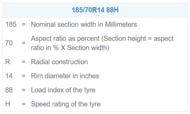
Light Truck Tyre Sizing
SSizing for light truck tyres takes the performance requirements of the vehicle, and the tyres, into account. Light truck tyres have evolved along with the expanded applications of trucks and vans that have grown to be multi-purpose vehicles that we use for work, for recreation or as passenger vehicles. There are three primary light truck tyre sizing systems: Light Truck Metric, Light Truck High Floatation and Light Truck Numeric.
Light Truck Metric
This sizing system mirrors the P-Metric system for passenger tyres.

Light Truck High Flotation
Light truck high flotation tyres have evolved as lower aspect ratio tyres became more popular on light trucks. The combination of lower aspect ratios and high flotation yielded better traction on sand and soft soil found in off-road situations.
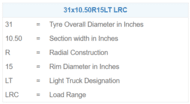
Light Truck Numeric
This older system is still widely used, mostly on commercial vehicles.

How do I read the DOT number?
DOT signifies that the tyre complies with the United States Department of Transportation tyre safety standards, and is approved for highway use.
Example:
DOT M5H3 459X 065
The first two digits following DOT designate the tyre's manufacturer and plant code. The third and fourth characters denote the tyre size. The fifth, sixth, seventh and eighth (optional) characters identify the brand and other significant characteristics of the tyre. The ninth and tenth characters denote the week the tyre was produced. The final number(s) signifies the year in which the tyre was manufactured.
For Michelin brand tyres, DOT markings related to the week and year of production will have an additional symbol for the decade of the 1990s. It will be shown as a triangle following these last three numbers.EXAMPLE: 065This would designate the 6th week of 1995.

Beginning in year 2000, an additional digit was added to the serial number to allow the year of production to have two digits.

Note: DOT is mandatory for tyres to be used in US and so some of the Michelin tyres sold in South Africa, may not carry the letters “DOT’ though the manufacturing details are mentioned in the same order.
How much load/weight can my tyre carry?
Never exceed the load-carrying limits molded on the sidewall of the tyres or the maximum vehicle axle load limit as shown on the vehicle tyre placard, whichever is less. Overloading builds up excessive heat in the tyre and could lead to failure.
What are zero pressure tyres?
Zero pressure tyres are designed to operate for a limited time with little or no air pressure without causing damage to the tyre casing. In order to realize the zero pressure benefits, the tyres must be mounted on proper wheels.
What guidelines should I follow when mixing tyres on 4WD vehicles?
If no instructions for tyre mixing appear in the vehicle owner’s manual, adhere to the following guidelines:
- Do not mix sizes. All four tyres must be branded with the same tyre size.
- Do not mix radial and non-radial tyres. All four tyres must be either radial or non-radial.
- Be sure that the outside circumference of all four tyres is within one (1) inch of each other.
- Do not mix tread pattern types such as all-terrain and all-season.
What is a Directional tread design?
Tyres with directional tread patterns must be mounted so that the primary direction of rotation matches the directional arrows on the tyre sidewall. If all four tyres are the same size, directional tyres can be rotated front to back.
What is an Asymmetric tread design?
Asymmetric tyres are characterised by different outside and inside tread pattern. One of the sidewall carry marking “Outside” and while fitting one needs to ensure that this side of the sidewall is fitted facing outside.
What is Excessive Spinning?
Excessive wheel spinning, when freeing a vehicle from sand, mud, snow, gravel, ice or wet surfaces, can result in explosive tyre failure, causing serious personal injury or vehicle damage. Never stand near, or behind, a tyre spinning at high speeds when attempting to push a vehicle that is stuck.
What is Speed ratings?
The speed rating of a tyre indicates the speed category (or range of speeds) at which the tyre can carry a load under specified service conditions. The speed rating system used today was developed in Europe in response to the need to categorize tyres into standardized speeds. A letter from A to Z symbolizes a tyre's certified speed rating, ranging from 5km/h (3 mph) to above 300 km/h (186 mph).
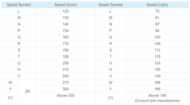
Where are your tyres manufactured?
We are an international company, with manufacturing operations at 67 plants across 17 countries around the world. To meet the needs of our customers by providing more specialized tyre lines, please be assured that no matter where your tyres are manufactured, they are built to the standards that have made our products the benchmark for the industry.
Where can I find the DOT on my tyre and what does it signify?
The "DOT" symbol certifies the tyre manufacturer's compliance with the U.S. Department of Transportation tyre safety standards. Tyres manufactured have the full DOT serial number located on one sidewall near the rim. A partial DOT serial number will appear on the opposite side of the tyre.
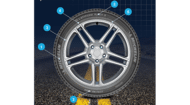
- Brand Name
- Tyre line name
- Tyre size
275 - Nominal tyre width in mm
40 - Aspect ratio (ratio of height to width: 0.55)
R - Radial construction
20 - Rim seat diameter in inches
106 - Load capacity index
Y - Maximum speed index - DOT - USA Department of Transportation
Last 4 digits: Week and year of manufacture - European Regulation ECE 30 approval number
Company Information
Where can I obtain pricing information?
All our tyres are sold through our network of retailers. We do not sell direct to the public.
The tyre retailer establishes pricing on tyres. For pricing on our tyres, please contact your local participating dealer. Call us at 0860 100 480 for any questions or queries.
Who do I contact about a career with Michelin?
Please visit our website to view all the current job openings.




